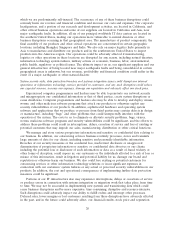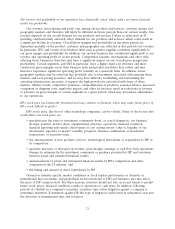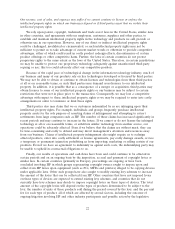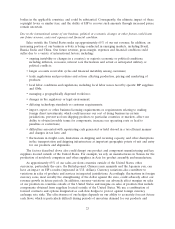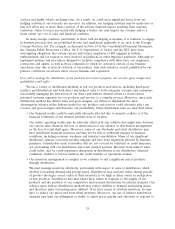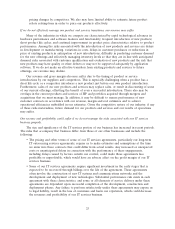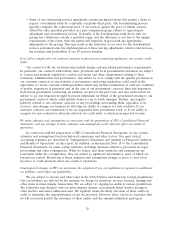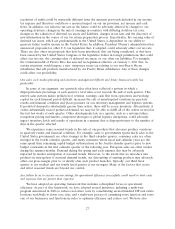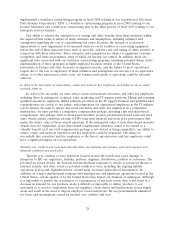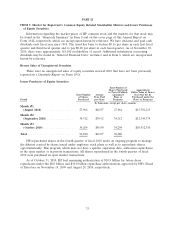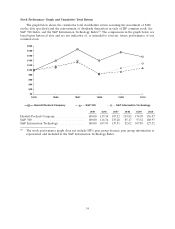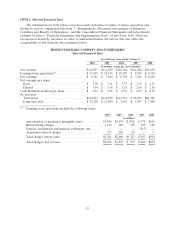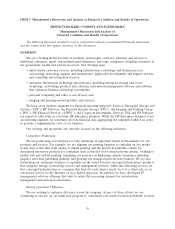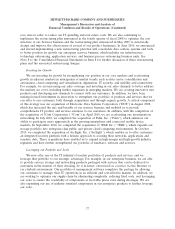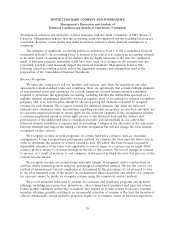HP 2010 Annual Report Download - page 37
Download and view the complete annual report
Please find page 37 of the 2010 HP annual report below. You can navigate through the pages in the report by either clicking on the pages listed below, or by using the keyword search tool below to find specific information within the annual report.Any failure by us to identify, manage, complete and integrate acquisitions, divestitures and other significant
transactions successfully could harm our financial results, business and prospects, and the costs, expenses
and other financial and operational effects associated with managing, completing and integrating
acquisitions may result in financial results that are different than expected.
As part of our business strategy, we frequently acquire complementary companies or businesses,
divest non-core businesses or assets, enter into strategic alliances and joint ventures and make
investments to further our business (collectively, ‘‘business combination and investment transactions’’).
In order to pursue this strategy successfully, we must identify suitable candidates for and successfully
complete business combination and investment transactions, some of which may be large and complex,
and manage post-closing issues such as the integration of acquired companies or employees. We may
not fully realize all of the anticipated benefits of any business combination and investment transaction,
and the timeframe for achieving benefits of a business combination and investment transaction may
depend partially upon the actions of employees, suppliers or other third parties. In addition, the pricing
and other terms of our contracts for business combination and investment transactions require us to
make estimates and assumptions at the time we enter into these contracts, and, during the course of
our due diligence, we may not identify all of the factors necessary to estimate our costs accurately. Any
increased or unexpected costs, unanticipated delays or failure to meet contractual obligations could
make these transactions less profitable or unprofitable. Moreover, if we fail to identify and successfully
complete business combination and investment transactions that further our strategic objectives, we may
be required to expend resources to develop products and technology internally, we may be at a
competitive disadvantage or we may be adversely affected by negative market perceptions, any of which
could adversely affect our revenue, gross margin and profitability.
Integration issues are complex, time-consuming and expensive and, without proper planning and
implementation, could significantly disrupt our business. The challenges involved in integration include:
• combining product offerings and entering into new markets in which we are not experienced;
• convincing customers and distributors that the transaction will not diminish client service
standards or business focus, preventing customers and distributors from deferring purchasing
decisions or switching to other suppliers (which could result in our incurring additional
obligations in order to address customer uncertainty), minimizing sales force attrition and
coordinating sales, marketing and distribution efforts;
• consolidating and rationalizing corporate IT infrastructure, which may include multiple legacy
systems from various acquisitions and integrating software code;
• minimizing the diversion of management attention from ongoing business concerns;
• persuading employees that business cultures are compatible, maintaining employee morale and
retaining key employees, engaging with employee works councils representing an acquired
company’s non-U.S. employees, integrating employees into HP, correctly estimating employee
benefit costs and implementing restructuring programs;
• coordinating and combining administrative, manufacturing, research and development and other
operations, subsidiaries, facilities and relationships with third parties in accordance with local
laws and other obligations while maintaining adequate standards, controls and procedures;
• achieving savings from supply chain integration; and
• managing integration issues shortly after or pending the completion of other independent
transactions.
Managing business combination and investment transactions requires varying levels of management
resources, which may divert our attention from other business operations. These business combination
29



